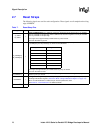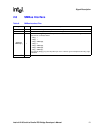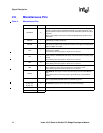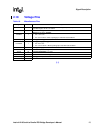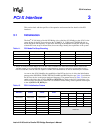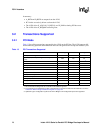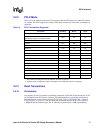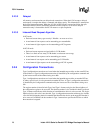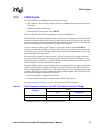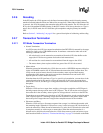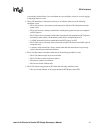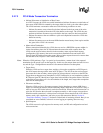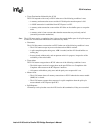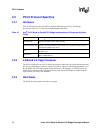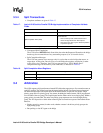
28 Intel
®
41210 Serial to Parallel PCI Bridge Developer’s Manual
PCI-X Interface
3.2.3.2 Delayed
All memory read transactions are delayed read transactions. When the 41210 accepts a delayed
read request, it samples the address, command, and address parity. This information is entered into
the delayed transaction queue. When the 41210 is in PCI-X mode, transactions follow the split
transaction model of PCI-X. Read data returned from PCI Express* for an active delayed
transaction entry is forwarded to the PCI-X master as a split completion.
3.2.3.3 Inbound Read Request Algorithm
In PCI mode:
• Each read stream always gets exactly 1 K buffer—no more or no less.
• A maximum of four requests can be outstanding per stream/buffer.
• A maximum of eight requests can be outstanding per PCI segment.
In PCI-X mode:
• Each read stream requests and gets buffer in 512 B chunks.
• There is no limit on how many 512 B chunks a read stream can occupy.
• A maximum of four requests can be outstanding per stream.
• A maximum of one request can be outstanding per 512 B buffer.
• A maximum of eight requests can be outstanding per PCI-X segment.
3.2.4 Configuration Transactions
Type 0 configuration transactions are issued when the intended target resides on the same PCI bus
as the initiator. A Type 0 configuration transaction is identified by the configuration command and
by the lowest two bits of the address being set to 00b.
Type 1 configuration transactions are issued when the intended target resides on another PCI bus,
or when a special cycle is to be generated on another PCI bus. A Type 1 configuration transaction
is identified by the configuration command and by the lowest two bits of the address being set to
01b.
The register number is found in both Type 0 and Type 1 formats and gives the Dword address of
the configuration register to be accessed. The function number is also included in both Type 0 and
Type 1 formats and indicates which function of a multifunction device is to be accessed. For single-
function devices, this value is not decoded. Type 1 configuration transaction addresses also include
a five-bit field designating the device number that identifies the device on the target PCI bus that is
to be accessed. In addition, the bus number in Type 1 transactions specifies the PCI bus to which
the transaction is targeted.



